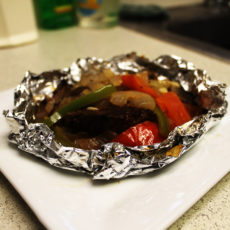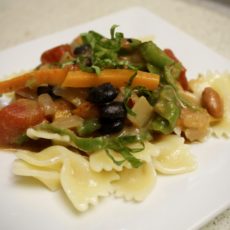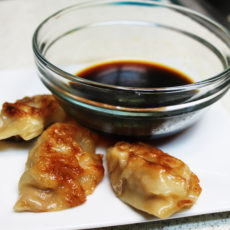Simply Delicious has several takes on pizza–we’ve covered quite a few already including 13-11: Vegetarian Pizza, 1-9: Four Seasons Pizza, and 5-31: Oven Pizza Pancake. There’s even 11-4: Calzone with Seafood if you like your pizza folded in half with toppings on the inside. 9-16: Individual Salami Pizzas is probably one of the more “traditional” pizza recipes so far.

It’s recommended to make this for something like a kid’s party, since it’s pretty tough to find a kid who will say no to pizza. I was a teacher for several years, ran a meal program for a school for a year or two, and I’m here to tell you that pizza (in whatever shape/form/capacity) was always a crowd pleaser for young and old.

There’s a lot of options listed under the TIPS section for sauce variations–feel free to branch out from tomato-based sauces if that’s not your thing. I personally am not a huge fan of most commercial tomato sauce–I often find it too sweet/acidic.
You can use this recipe for the dough and change the toppings out to make yourself a BBQ, pesto, Alfredo, or any other kind of pizza you like.

Ingredients. I’m going with a blend of tomato sauce and paste for my sauce (trying to stick to the recipe where possible for now) and a Colby-Jack blend for cheese. I also happened to have some pepperoni slices in the fridge, so I’m going to use BOTH pepperoni AND salami on these pizzas.

Starting the dough. I’ve noticed that Simply Delicious tends to have you start with blooming the yeast, then adding the flour and other dry ingredients. Other dough recipes I’ve worked with (including during my brief professional culinary phase) have you often times mix all of the dry ingredients together (including the yeast) and then mix the water in with that–no preliminary yeast bloom needed. With modern yeast production methods, as long as the yeast isn’t old or stored poorly, it doesn’t quite matter in which order you do it.

After starting to incorporate the oil.

Looks like pizza dough to me. My favorite from-scratch pizza dough recipe is from J. Kenji Lopez-Alt of Serious Eats, but this one gets the job done as well.

Chopped the ball into quarters to split it into 4 roughly even pieces.

When I would make pizza for the school I cooked for using that recipe from Serious Eats I linked above, I would put each dough ball into a zippered plastic bag with just a portion of it left open to vent air. Those would rise in the fridge for 1-2 days (depending on how far in advance I was able to make it) and the bags would go from maybe 1/4 full to 2/3 full in that amount of time as the dough proofed.
Since they’re having you use a much shorter proof time for this recipe, I’ll use two bowls to give them room to spread out while keeping in mind the small amount of proofing space I have.

Slicing up green onions–these ones were a little floppy from being in the fridge a tad too long, but since they’re going to be baked on top of pizza, they’re still usable.

Making my own sauce blend–to counter the usual over-sweet/acidic problem I find with most commercial sauces, I like to spice up unseasoned canned sauce (if I’m not using blended-up crushed/diced tomatoes) with some balsamic vinegar and brown sugar instead. That way, you’re still getting those necessary sweet/acid flavors, but with better quality, smoother ingredients at controlled-by-you levels.
Pre-made sauce tends to be overly sweetened with corn syrup or white sugar (in my experience) and overly-acidic due to the use of citric acid instead of a good wine-based vinegar (or wine itself). Adding a bit of tomato paste to this sauce that I’ve made will add a bit of that extra tang and viscosity that pizza sauce traditionally tends to have.

Since I’m using what’s essentially a canned sauce base, I’ll use a few fresh tomato slices for the tops.

Ready to make pizzas–I could be my very own Pieology (if you don’t have these by you, it’s essentially Chipotle or Subway but with pizza).

After rising. They definitely got bigger, even in just 30 minutes. You won’t get quite the same amount of crust bubbling that you would with a longer rise, but you’ll still get a very nice pizza.

Spreading the tomato sauce on two of the crusts. I’m using a half-size sheet pan with a Silpat on it. A good alternative to the Silpat (and somewhat “authentic”) is to use a dusting of cornmeal on the pan before putting the dough down. This will keep your dough from sticking to the pan and give you that slightly dusty crust you’re used to from most delivery pizzas.

Here’s where the fun part comes in. I tried all different variations and arrangements of toppings–I suppose I wanted to see which ones cooked better. I also wanted to see which combination kept the rest of the toppings on the best when you took a bite out of it.

All sorts of variations.

Each one a unique expression of pizza.

Add a light sprinkling of Parmesan cheese and some green on top for color.

From fancy to more standard-looking.

After cooking. These needed to go a bit longer–go with what looks right and your individual oven’s characteristics over sticking strictly to a prescribed time limit.

All four after baking. They have you bake these at 400ºF–I routinely would cook pizza at work at around 550ºF (with convection) because that’s as hot as I could get their oven to go. Most professional pizza ovens operate anywhere from 600ºF to 800ºF.
Pizza cooks best hot, fast, and dry–low and slow leads to soggy, unhappy pizza.
I definitely think these would have been better at a hotter temperature with a slightly reduced cooking time, depending on the toppings used.

The toppings in the middle got a bit of color, but the crusts are still a bit light.

More heat would have fused the ingredients together better as well.

Final result: it looks somewhat nice (this one got the most color), but their methods could use a bit of refinement. Pizza at home was still relatively new in the 1980s, and “fancy pizza” was still yet to really be any kind of a thing outside of Spago in Beverly Hills at this point.
However, use this as a base point (much like 11-4: Calzone with Seafood) to explore your own pizza skills. Pizza at home really isn’t that hard, once you’ve done it a few times. 🍕
Grade: A-



